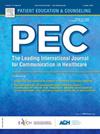Optimising invitation and advance notification letters to increase bowel cancer screening participation: A qualitative analysis
IF 2.9
2区 医学
Q2 PUBLIC, ENVIRONMENTAL & OCCUPATIONAL HEALTH
引用次数: 0
Abstract
Objectives
To explore how letters distributed in population bowel cancer screening programmes could be modified to increase bowel cancer screening uptake, from the perspective of screening invitees.
Methods
Sixty-three people aged 48–74 years discussed their preferences regarding letter design and content during semi-structured interviews aided by various example letters designed to notify of, or invite participants to, the Australian National Bowel Cancer Screening Programme (NBCSP). Deductive thematic analysis, informed by the Integrated Screening Action Model (I-SAM), was used to interpret participant feedback and provide recommendations for improvements to the letters in alignment with the theoretical stages of bowel cancer screening behaviour (engaging, deciding, and completing the screening kit).
Results
Participants generally agreed that effective letters should feature a clear, eye-catching design to enhance initial engagement. Messages targeting emotional barriers and content tailored to prior screening history were seen as crucial to drive screening decision-making. Finally, step-by-step instructions, deadlines, and reminders were identified as facilitators of kit completion, bridging the gap between intention and action.
Conclusions
The findings of this study align with the I-SAM framework for understanding the progression of screening behaviours and highlight key design elements that can enhance the effectiveness of bowel cancer screening invitations. The design and messaging within screening letters has the potential to address common concerns and encourage screening participation.
Practice implications
The simplification of letter design, and integration of tailored messaging strategies, simple kit instructions, reminders, and deadlines could boost engagement and help bridge the intention-behaviour gap, driving increased screening participation.
优化邀请和提前通知信以增加肠癌筛查的参与:一项定性分析
目的从筛查对象的角度,探讨如何修改人群中肠癌筛查计划的信件,以增加肠癌筛查的接受度。方法63名年龄在48-74岁之间的人在半结构化访谈中讨论了他们对信函设计和内容的偏好,这些信函旨在通知或邀请参与者参加澳大利亚国家肠癌筛查计划(NBCSP)。由综合筛查行动模型(I-SAM)提供信息的演绎主题分析用于解释参与者的反馈,并根据肠癌筛查行为的理论阶段(参与、决定和完成筛查工具包)提供改进字母的建议。结果与会者普遍认为,有效的信件应具有清晰,醒目的设计,以提高最初的参与。针对情感障碍的信息和针对先前筛查历史的内容被视为推动筛查决策的关键。最后,一步一步的说明、最后期限和提醒被确定为工具包完成的促进因素,弥合了意图和行动之间的差距。本研究的结果与I-SAM框架一致,用于理解筛查行为的进展,并突出了可以提高肠癌筛查邀请有效性的关键设计元素。筛查信的设计和信息传递有可能解决共同关注的问题,并鼓励参与筛查。实践意义简化信件设计,整合定制的信息策略,简单的工具包说明,提醒和截止日期可以提高参与度,帮助弥合意图-行为差距,推动更多的筛查参与。
本文章由计算机程序翻译,如有差异,请以英文原文为准。
求助全文
约1分钟内获得全文
求助全文
来源期刊

Patient Education and Counseling
医学-公共卫生、环境卫生与职业卫生
CiteScore
5.60
自引率
11.40%
发文量
384
审稿时长
46 days
期刊介绍:
Patient Education and Counseling is an interdisciplinary, international journal for patient education and health promotion researchers, managers and clinicians. The journal seeks to explore and elucidate the educational, counseling and communication models in health care. Its aim is to provide a forum for fundamental as well as applied research, and to promote the study of organizational issues involved with the delivery of patient education, counseling, health promotion services and training models in improving communication between providers and patients.
 求助内容:
求助内容: 应助结果提醒方式:
应助结果提醒方式:


